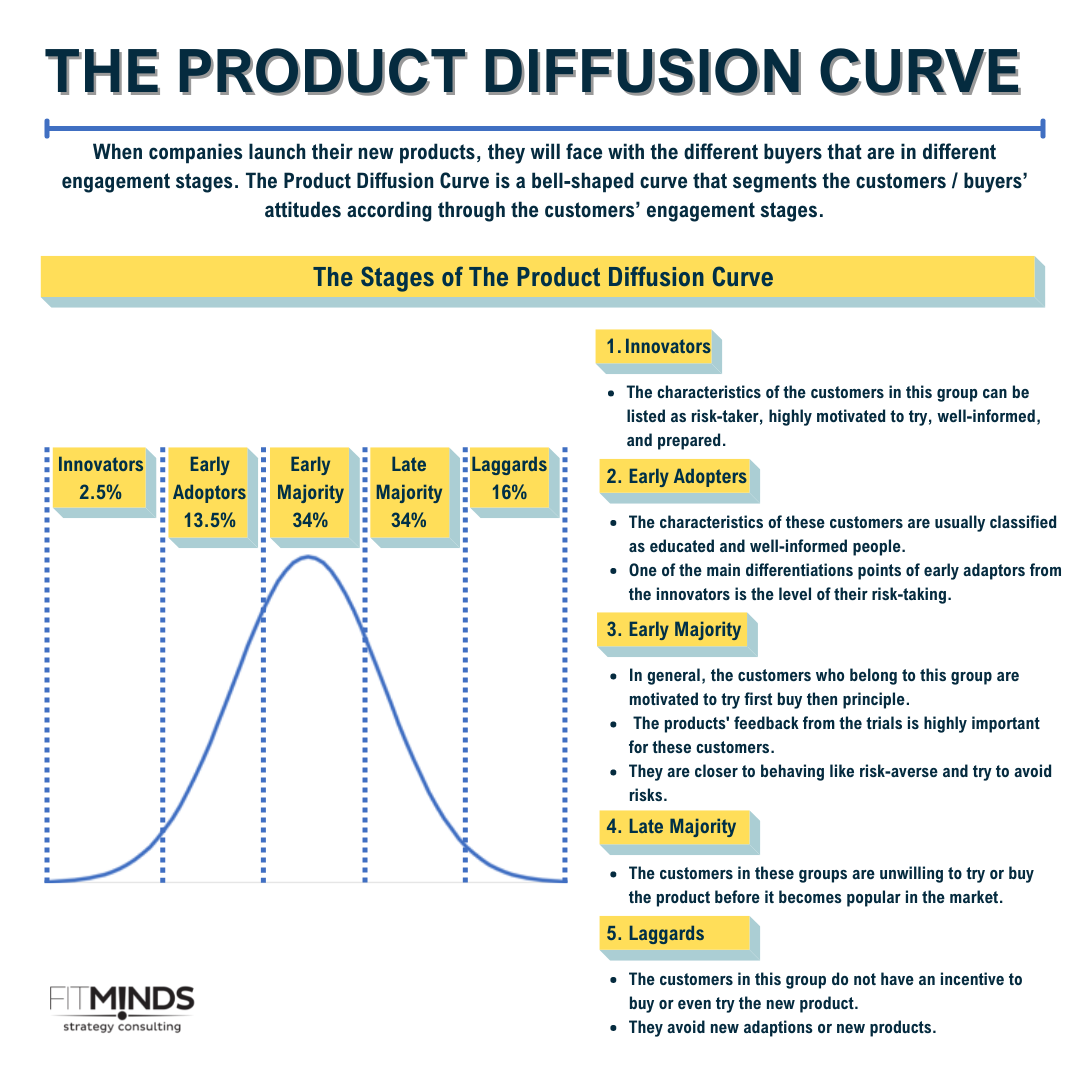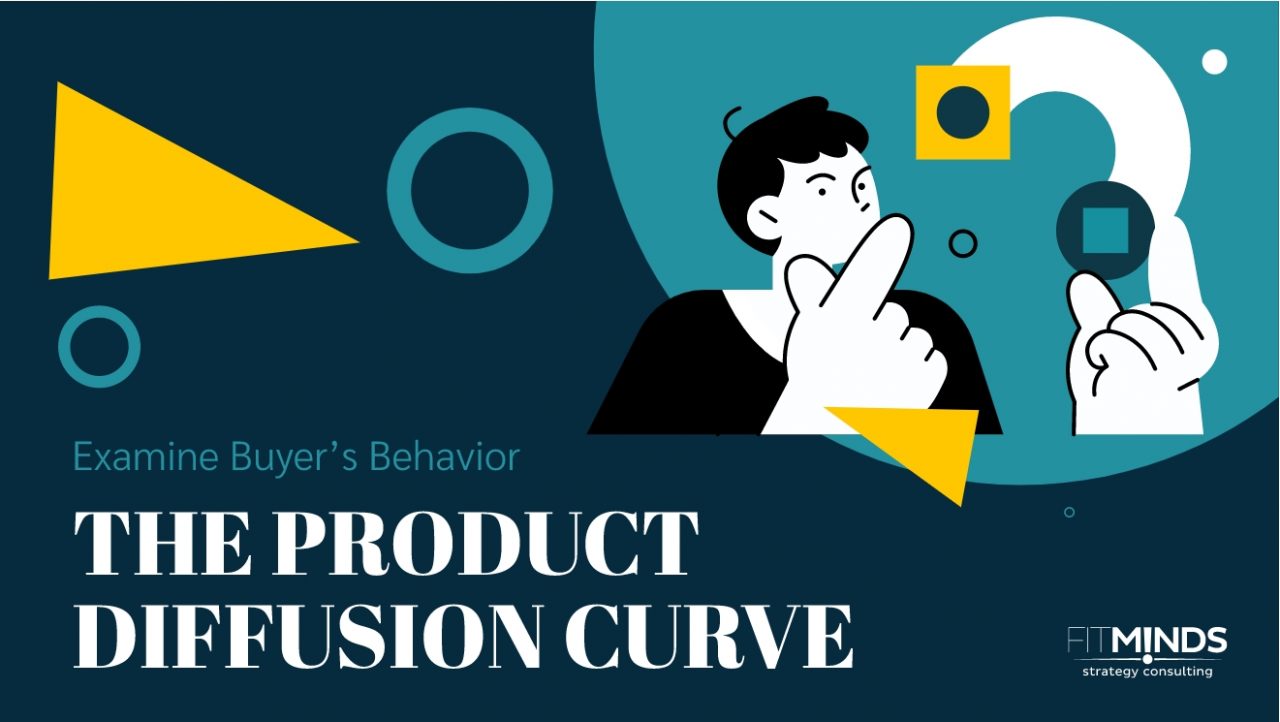For companies in all industries, the perceptions of their products in their buyers’ minds carry high importance for their profitability, sustainability, and the future of their companies. When companies launch their new products, they will face different buyers that are in different engagement stages. The Product Diffusion Curve is a bell-shaped curve that segments the customer’s/buyers’ attitudes according to the customers’ engagement stages.
Main Benefits of The Product Diffusion Curve
The product diffusion curve assists companies in increasing their performance for their new product launches as a part of their strategic analysis. The curve indicates the engagement stages of the customers for the product.
The Product Diffusion Curve helps you:
- To identify the behaviors of buyers for the new product.
- To separation of the customers into their engagement level segments, companies can edit or plan their marketing strategies for each customer engagement group.
- To provide valuable insights for marketing activities, planning of raw materials, forecasting sales, and business strategy planning with the adaption of the customers’ behavioral data.
Explanation of The Product Diffusion Curve
The Product Diffusion Curve divides the customers’ engagement rate for the newly launched products into five groups: Innovators, Early Adopters, Early Majority, Late Majority, and Laggards. These customer engagement groups are settled according to a few criteria. The price, the advantages of the products, the perception of the brand (familiarity and strength of the brand), the perceived benefits of the product (in comparison to its competitors), the risk perception of the customer in buying process), the strength of distribution, the attractiveness of the product’s packaging and the marketing & advertising exercises of the products are the criteria to segment the customers into their engagement groups.

- Innovators:
The first group in the product diffusion curve is the innovators. Innovators indicate the top 2.5% of the customers. The characteristics of customers in this group can be listed as risk-taker, highly motivated to try, well-informed, and prepared.
- Early Adopters:
After the innovators, the early adopters are listed as the second group in the curve. They indicate that 13.5% of the company’s customers. The characteristics of these customers are usually classified as educated and well-informed people. One of the main differentiations points of early adaptors from innovators is the level of their risk-taking.
- Early Majority
On the product diffusion curve, one of the largest groups of customers belongs to the early majority segment. They represent 34% of the company’s customers. In general, the customers who belong to this group are motivated to try first buy then principle. Before they are involved in the process of buying, they wait for trials of the product or tested them themselves. The product feedback from the trials is highly important for these customers. They are closer to behaving like risk-averse and try to avoid risks.
- Late Majority
The other largest customer group in the product diffusion curve is the late majority segment, 34% of the customers. The customers in these groups are unwilling to try or buy the product before it becomes popular in the market.
- Laggards
The last group in the curve is the laggards. They indicate the group for the firms that are hardest to reach. They are 16% of the customers. The customers in this group do not have an incentive to buy or even try the new product. They avoid new adaptions or new products. Because they have taboos to buy and try new products and also they have represents 16% of the customers, reaching the customers in this group is hard but profitable in general.
How to personalize the Product Diffusion Curve in your business?
To conduct personalized segmentation of your customer according to their response level on your product/ products, FITMINDS is providing an adoption of the Production Diffusion Curve that fits your company.
To get a more specialized version of the customer segmentation strategy to receive a personalized target campaign and/or campaign set for each covered customer (pharmacy or pet shop), Customer Incentive Wizard is what you are looking for. To get more information about Customer Incentive Wizard, you can check.
Contact us to customize the Product Diffusion Curve to segment your customers according to their response levels in your business.
Contact us to get more information or discover your probable personalized roadmap for Customer Incentive Wizard.



13 comments
Pingback: achat kamagra prescrire united nations medicament
Pingback: buying enclomiphene uk delivery
Pingback: se necesita receta medica para comprar androxal
Pingback: buy cheap dutasteride us pharmacies
Pingback: Where can i buy flexeril cyclobenzaprine no perscription
Pingback: how to order gabapentin price singapore
Pingback: order fildena australia buy online
Pingback: get itraconazole non prescription online
Pingback: cheap staxyn generic does it work
Pingback: how to order avodart cheap canada pharmacy
Pingback: order xifaxan generic equivalent buy
Pingback: rifaximin online without prescription canada
Pingback: kamagra bez rx
Comments are closed.